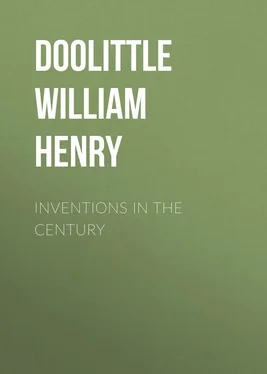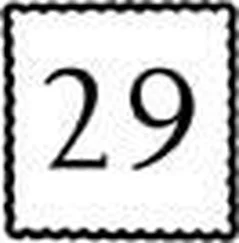William Doolittle - Inventions in the Century
Здесь есть возможность читать онлайн «William Doolittle - Inventions in the Century» — ознакомительный отрывок электронной книги совершенно бесплатно, а после прочтения отрывка купить полную версию. В некоторых случаях можно слушать аудио, скачать через торрент в формате fb2 и присутствует краткое содержание. Жанр: foreign_antique, foreign_prose, на английском языке. Описание произведения, (предисловие) а так же отзывы посетителей доступны на портале библиотеки ЛибКат.
- Название:Inventions in the Century
- Автор:
- Жанр:
- Год:неизвестен
- ISBN:нет данных
- Рейтинг книги:5 / 5. Голосов: 1
-
Избранное:Добавить в избранное
- Отзывы:
-
Ваша оценка:
- 100
- 1
- 2
- 3
- 4
- 5
Inventions in the Century: краткое содержание, описание и аннотация
Предлагаем к чтению аннотацию, описание, краткое содержание или предисловие (зависит от того, что написал сам автор книги «Inventions in the Century»). Если вы не нашли необходимую информацию о книге — напишите в комментариях, мы постараемся отыскать её.
Inventions in the Century — читать онлайн ознакомительный отрывок
Ниже представлен текст книги, разбитый по страницам. Система сохранения места последней прочитанной страницы, позволяет с удобством читать онлайн бесплатно книгу «Inventions in the Century», без необходимости каждый раз заново искать на чём Вы остановились. Поставьте закладку, и сможете в любой момент перейти на страницу, на которой закончили чтение.
Интервал:
Закладка:
Electricity produced by friction, that is, developed upon the surface of a body by rubbing it with a dissimilar body, and called frictional or static electricity, was the only kind produced artificially in the days of Franklin. What is known as galvanism, or animal electricity, also takes its date in the 18th century, to which further reference will be made. Since 1799 there have been discovered additional sources, among which are voltaic electricity, or electricity produced by chemical action, such as is manifested when two dissimilar metals are brought near each other or together, and electrical manifestations produced by a decomposing action, one upon the other through a suitable medium; inductive electricity, or electricity developed or induced in one body by its proximity to another body through which a current is flowing; magnetic electricity, the conversion of the power of a magnet into electric force, and the reverse of this, the production of magnetic force by a current of electricity; and thermal electricity, or that generated by heat. Electricity developed by these, or other means in contra-distinction to that produced by friction, has been called dynamic; but all electric force is now regarded as dynamic, in the sense that forces are always in motion and never at rest.
Many of the manifestations and experiments in later day fields which, by reason of their production by different means, have been given the names of discovery and invention, had become known to Franklin and others, by means of the old methods in frictional electricity. They are all, however, but different routes leading to the same goal. In the midst of the brilliant discoveries of modern times confronting us on every side we should not forget the honourable efforts of the fathers of the science.
We need not dwell on what the ancients produced in this line. It was a single fact only: – The Greeks discovered that amber, a resinous substance, when rubbed would attract lighter bodies to it.
In 1600 appeared the father of modern electricity – Dr. Gilbert of Colchester, physician to Queen Elizabeth. He revived the one experiment of antiquity, and added to it the further fact that many substances besides amber, when rubbed, would manifest the same electric condition, such as sulphur, sapphire, wax, glass and other bodies. And thus he opened the field of electrodes. He was the first to use the terms, electricity, electric and electrode, which he derived from the word elektron , the Greek name for amber. He observed the actions of magnets, and conjectured the fundamental identity of magnetism and electricity. He arranged an electrometer, consisting of an iron needle poised on a pivot, by which to note the action of the magnet. This was about the time that Otto von Guericke of Magdeburg, Germany, was born. He became a "natural" philosopher, and for thirty-five years was burgomaster of his native town. He invented the air-pump, and he it was who illustrated the force of atmospheric pressure by fitting together two hollow brass hemispheres which, after the air within them had been exhausted, could not be pulled apart. He also invented a barometer, and as an astronomer suggested that the return of comets might be calculated. He invented and constructed the first machine for generating electricity. It consisted of a ball of sulphur rotated on an axis, and which was electrified by friction of the hand, the ball receiving negative electricity while the positive flowed through the person to the earth. With this machine "he heard the first sound and saw the first light in artificially excited electricity." The machine was improved by Sir Isaac Newton and others, and before the close of that century was put into substantially its present form of a round glass plate rotated between insulated leather cushions coated with an amalgam of tin and zinc, the positive or vitreous electricity thus developed being accumulated on two large hollow brass cylinders with globular ends, supported on glass pillars. Gray in 1729 discovered the conductive power of certain substances, and that the electrical influence could be conveyed to a distance by means of an insulated wire. This was the first step towards the electric telegraph.
Dufay, the French philosopher and author, who in 1733-1737 wrote the Memoirs of the French Academy , was, it seems, the first to observe electrical attractions and repulsions; that electrified resinous substances repelled like substances while they attracted bodies electrified by contact with glass; and he, therefore, to the latter applied the term vitreous electricity and to the former the term resinous electricity. In 1745 Prof. Muschenbroeck of Leyden University developed the celebrated Leyden jar. This is a glass jar coated both inside and outside with tinfoil for about four-fifths of its height. Its mouth is closed with a cork through which is passed a metallic rod, terminating above in a knob and connected below with the inner coating by a chain or a piece of tinfoil. If the inner coating be connected with an electrical machine and the outer coating with the earth, a current of electricity is established, and the inner coating receives what is called a positive and the outer coating a negative charge. On connecting the two surfaces by means of a metallic discharger having a non-conducting handle a spark is obtained. Thus the Leyden jar is both a collector and a condenser of electricity. On arranging a series of such jars and joining their outer and inner surfaces, and connecting the series with an electrical machine, a battery is obtained of greater or less power according to the number of jars employed and the extent of supply from the machine.
The principle of the Leyden jar was discovered by accident. Cuneus, a pupil of Muschenbroeck, was one day trying to charge some water in a glass bottle with electricity by connecting it with a chain to the sparking knob of an electrical machine. Holding the bottle in one hand he arranged the chain with the other, and received a violent shock. His teacher then tried the experiment himself, with a still livelier and more convincing result, whereupon he declared that he would not repeat the trial for the whole Kingdom of France.
When the science of static electricity was thus far developed, with a machine for generating it and a collector to receive it, many experiments followed. Charles Morrison in 1753, in the Scots Magazine , proposed a telegraph system of insulated wires with a corresponding number of characters to be signalled between two stations. Other schemes were proposed at different times down to the close of the century.
Franklin records among several other experiments with frictional electricity accumulated by the Leyden jar battery the following results, produced chiefly by himself: The existence of an attractive and a repulsive action of electricity; the restoration of the equilibrium of electrical force between electrified and non-electrified bodies, or between bodies differently supplied with the force; the electroscope, a body charged with electricity and used to indicate the presence and condition of electricity in another body; the production of work, as the turning of wheels, by which it was proposed a spit for roasting meat might be formed, and the ringing of chimes by a wheel, which was done; the firing of gunpowder, the firing of wood, resin and spirits; the drawing off a charge from electrified bodies at a near distance by pointed rods; the heating and melting of metals; the production of light; the magnetising of needles and of bars of iron, giving rise to the analogy of magnetism and electricity.
Franklin, who had gone thus far, and who also had drawn the lightning from the clouds, identified it as electricity, and taught the mode of its subjection, felt chagrined that more had not been done with this subtle agent in the service of man. He believed, however, that the day-spring of science was opening, and he seemed to have caught some reflection of its coming light. Observing the return to life and activity of some flies long imprisoned in a bottle of Madeira wine and which he restored by exposure to the sun and air, he wrote that he should like to be immersed at death with a few friends in a cask of Madeira, to be recalled to life a hundred years thence to observe the state of his country. It would not have been necessary for him to have been embalmed that length of time to have witnessed some great developments of his favorite science. He died in 1790, and it has been said that there was more real progress in this science in the first decade of the nineteenth century than in all previous centuries put together.
Читать дальшеИнтервал:
Закладка:
Похожие книги на «Inventions in the Century»
Представляем Вашему вниманию похожие книги на «Inventions in the Century» списком для выбора. Мы отобрали схожую по названию и смыслу литературу в надежде предоставить читателям больше вариантов отыскать новые, интересные, ещё непрочитанные произведения.
Обсуждение, отзывы о книге «Inventions in the Century» и просто собственные мнения читателей. Оставьте ваши комментарии, напишите, что Вы думаете о произведении, его смысле или главных героях. Укажите что конкретно понравилось, а что нет, и почему Вы так считаете.












